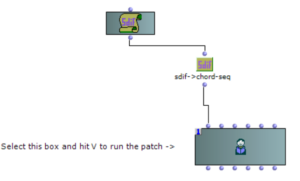Although it has been discussed in the 1st submission, and has been referenced throughout, I thought I should make a blog post about how the music was constructed in the first layer, as to be very clear. The chords are based on spectral analysis on both samples of whalesong, and the sea creature sound effects made for the section. The spectral analysis was done by using the programme SPEAR. 
Figure 1, analysis of a sea creature sound effect.
This is then converted into notation by using an SDIF (SPEAR file) to score converter, as notating out manually would give a much less precise result. 
Figure 2: Image of a spectrogram-chord generator on Openmusic.
This technique of creating harmony from different sounds/timbres is a common technique in spectralism (Fineberg, 2000) a musical style emerging in the 1970s where the musical compositions are based on the natural spectra and/or acoustics of certain sounds (Harvey, 2000). Gérard Grisey work Partiels specifically uses this technique, instead with the harmony is based on the sound spectra of a low E on a trombone (Hasegawa, 2009). This is a more ‘literal’ interpretation of the sea than the other approaches, which I think is appropriate for establishing this layer, the fear of the sea creatures is represented by harmony based on the acoustic qualities of said creatures. Resulting sounds and notation can be found in the appendix.
Reference list.
Fineberg, J. (2000) Guide to the basic concepts and techniques of spectral music. Contemporary music review. 19 (2), p. 81–113.
Harvey, J. (2000) Spectralism. Contemporary music review. [Online] 19 (3), p. 11–14.
Hasegawa, R. (2009) Gérard Grisey and The “Nature” of Harmony. Music analysis. 28 (2/3), p. 349–371.

